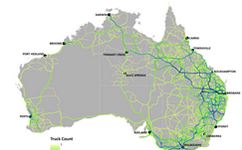



Tyranny Of Distance: Making Inroads into Cattle Trucking
AUSTRALIA – A travel simulator could make major savings by re-routing thousand kilometre cattle trucking routes in northern Australia.Researchers have shown haulage miles can be saved, improving the outlook for the environment, road safety and animal welfare if a route planning programme is adhered to.

Called TRANSIT (Transport Network Strategic Investment Tool), the CSIRO highlights the benefits of wear and tear to trucks, as well as fuel costs.
There is great potential in the logistics side of the Australian cattle sector, according to developers at the Commonwealth Scientific and Industrial Research Organisation (CSIRO) who say 40 per cent of cattle costs in northern Australia are swallowed up by trucking between production, processing and market facilities.
By focusing on northern regions, the study went straight to the heart of Australia's cattle trucking business, where 90 per cent of the country's live cattle exports originate.
In the region, over half the cattle travel over one thousand kilometres, what CSIRO describes as a major dent to productivity and profits.
Dubbing it 'the tyranny of distance', the CSIRO worked to find out how to increase the sustainability of the industry.
Industry consultations in developing the programme have been of particular relevance for ‘mum and dad’ trucking businesses.
The project looked at potential traffic burdens over a five year period, noting the impact of changes to infrastructure or biosecurity rules on road usage.
An exemption for trucks travelling from tick-free into tick-prone zones could save truckers passing through Queensland $2.3 million.
Wagon drivers opt for longer routes to avoid crossing borders as time is taken when undertaking compulsory treatments on cattle crossing into tick-infested zones.
Furthermore, strategically placed processing facilities would reduce the intensity of eastwards travelling trucks heading for the east coast ports and marketing hubs.
“In developing this tool we completed the most comprehensive mapping of the cattle supply chain in Australia,” said lead researcher, Dr Andrew Higgins.
“We can now use TRANSIT to identify key investments, large and small, at critical points in the supply chain, along with policy changes that might allow for better planning.”
He added that, while the industry had faced ‘tough times’ the northern states were planning for expansion.
“It gives us a truckie’s-eye view of a supply chain, factoring in thousands of small decisions in planning routes,” Dr Higgins said.
"Our hope is that this tool can make every long journey as short as it can be, and help to expand sustainable industry.”
TheCattleSite News Desk


